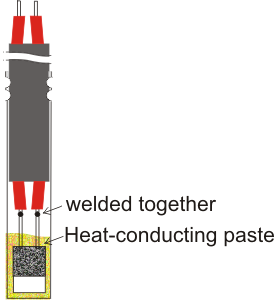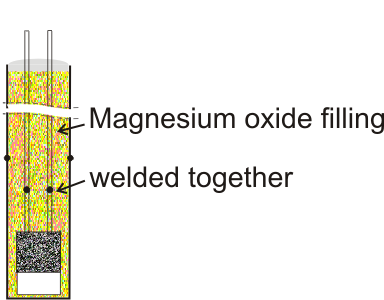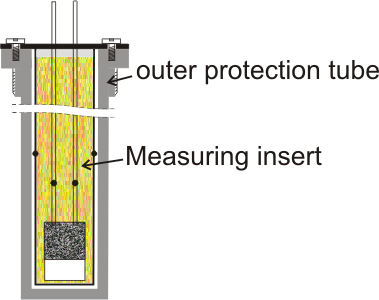Designs of Pt100 resistance thermometers
The most common structure of a Pt100 resistance thermometer for industrial application consists of:
- Pt100 sensing element
- Protection tube with mechanical connection
- Connection cable / connection head
- Transmitter / Display
Pt100 - sensor elements
Depending on the application, a distinction is made between 3 designs
- Thin-film sensors
- Wire wound ceramic resistors
- Wire wound glass resistors
Thin-film sensors
An approx. 1 mm thick platinum layer is vapor-deposited onto an aluminum oxide plate. The platinum layer is structured and aligned in a spiral with the aid of a laser beam. A glass layer is then applied to protect the platinum layer.The decisive advantage of the thin-film Pt100 sensor is its inexpensive large-scale production and its fast response time due to its low mass.
- Temperature range: -50...+400 (600) °C
- Length: from 2,5 mm
Wire wound Pt100 ceramic resistors
A coiled platinum wire is fed into a ceramic tube. For better heat transfer and to fix the winding, the tube is filled with aluminum oxide. By means of a glass plug, the ceramic tube is closed and the connecting wires are fixed. Since there is no connection between the aluminum oxide powder and the platinum filament, the Pt100 wire can expand freely when the temperature changes. The wire is only slightly stressed and therefore shows no hysteresis between rising and falling Temperatur.- Temperature range: -200...+800 °C
- Diameter: 0,9...4,5 mm
- Length: 7...30 mm
Wire wound Pt100 glass resistors
A platinum wire is wound onto a glass rod and fused into it. After the resistance has been adjusted, a second glass protection tube is slid over and fused to the glass rod. The wire is completely surrounded by the glass. Therefore, these glass resistors are particularly insensitive to vibration. With the glass tube fused on, Pt100 glass resistors are also used directly in aggressive media as fast-responding sensors.- Temperature range: -200...+400 (550) °C
- Diameter: 0,9...4,8 mm
- Length: 7...55 mm
Protection tubes or protective sleeve for Pt100 sensors with mechanical connection
For most industrial applications, the actual sensing element is installed in a so-called thermowell. This protects the sensor element from mechanical damage or chemical attack. In order to obtain an optimal measurement, some things have to be considered when selecting the protection tube and installing the Pt100 sensor.The thermowell should have a high thermal conductivity (e.g. metal) to ensure the heat transfer between
the medium and the Pt100 sensor element.
The thermowell must be chemically resistant to the medium and must be sufficiently pressure-resistant.
The construction of thermowells is recommended in DIN standards or often also produced in manufacturer/customer-specific
designs.
The Pt100 sensor element is installed in different ways:
Connection of the Pt100 sensor to a cable or stranded wire

For mechanical connection, threaded fittings, flanges, etc. can be connected. The use of compression fittings allows the sleeve to be moved and the installation length to be changed variably.
Advantage: inexpensive design
Connection Pt100 sensor to mineral insulated metal-sheathed cables

Advantage: Use at higher temperatures.
Measuring inserts

This enables defective sensors to be replaced even while the plant is in operation. The length of the measuring insert must be adapted to the protection tubes.